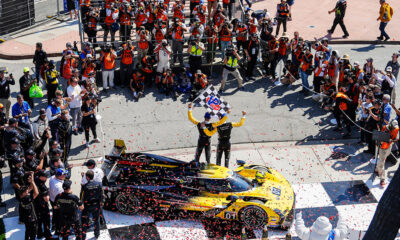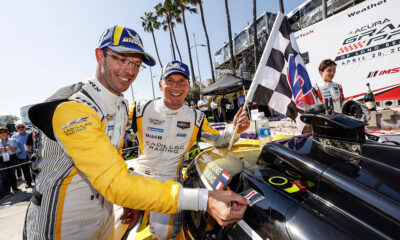
Photo: Regis Lefebure/Risi Competizione
Rick Mayer, race engineer of the No. 62 Risi Competizione Ferrari 488 GTE, provides a technical preview to this weekend’s Rolex 24 at Daytona, where the Houston-based team will field its GT Le Mans class entry for Alessandro Pier Guidi, Davide Rigon, James Calado and Daniel Serra.
General: The Roar weather was mainly dry; the race forecast has a high rain chance. This could mix things up a bit. All the GTLMs had a chance to test the different Michelin tire options on track at the Roar. Most of the GTLM field tested at Daytona before the Roar, except the Ferrari.
These are new tires for all GTLM cars, different than last season. These are the tires developed for WEC and each compound option is unique to each manufacturer.
Each GTLM team had to choose their limited allotment more than a month before the event week, before we actually ran on the tires at Daytona. Based on the forecast we’re happy with our choice. GTLM cars are allowed 37 total dry tire sets for the event, which includes all the practice sessions and the race. Quantity shouldn’t be an issue, if you selected the right compounds.
The pit rules are the same this year with Prototypes pitting first under the safety car and all GT’s pitting second. This should work out as the GTDs are required to take fuel slower. This should allow all the GTLMs to get out of the pits before the GTDs as fueling determines the pit stop time, unless it’s a really small amount of fuel. There’s a fueling advantage of 6 seconds on a full fill (from empty) for the GTLMs.
Minimum full fill time (from empty) is regulated at 34 seconds for GTLM and 40 seconds for GTD. Safety car fuel stops rarely occur when you need a full fill from empty so the actual difference will be proportionately less. I think we’ll see some GTDs mixed with GTLMs on restarts. The GTDs are so fast on the banking and with their ABS it’s difficult for GTLMs to pass without risk. Restarts could be tricky.
The pit boxes are arranged this year so under a safety every GTLM and every Prototype have a clear in and out of their pit box; meaning pit lane boxes are ordered P-GT-P-GT-P, etc. So under safety car stops the car in front and behind should not be in their pit box, some of the GTDs weren’t so fortunate.
Competitiveness: The IMSA WeatherTech specific balance of performance (BoP) GTLM rules evolved from last year’s Daytona without accounting for other 2019 races. IMSA uses a Daytona-specific BoP. The Ferrari didn’t fare well with this and will be at a disadvantage to the other GTLM manufacturers again this year. How this will play out, we’ll only know at the end of the race.
Last year BMW had a significant advantage on the banking with power. This year BMW and Porsche ‘should’ dominate the pace. But the new Corvette fared well and should run up front as it got more power than its front engine predecessor of last a year and is the lightest mid-engine car on the grid. Let’s hope the analysis that leads to this prediction is wrong and we are competitive. The GTLM competitors “displayed” performance will vary.
This is just the start to the long season. Risi is only signed up for this race; the others are signed up for the season. Showing what you have at Daytona might result in a BoP reduction that will carry through for the entire season. Teams will be cautious of what they show and when and how much true pace they display.
Setup and Track: Clearing traffic at Daytona is significant in setup considerations. There is a tradeoff between lower downforce (lower drag) for banking speed and higher downforce for better braking and power down at corner exits. Trimming downforce too much can be slower overall on the banking from compromising the exits leading onto the banking; but there is a limit.
There are also different minimum wing angle rules for each car specific to Daytona. Each car is built to a very car-specific homologation, very little can be changed by the team. The only way to really control banking speed (other than power) is by wing angle, to control drag. In addition to braking and power down at corner exits, the higher downforce also helps with the ‘bus stop’ and tire longevity/degradation.
But little passing is done in the infield so banking speed is important; if lap times are similar, choose better banking performance. These are all significant factors when racing for 24 hours, not just a lap time.
The Race: There were many safety car periods in last year’s race. Heavy rain shorted the race and finally stopped it in 2019. The larger LMP2 grid ‘could’ add more potential safety cars with more Am driver content in faster cars. This was the case when we had PC cars running in the series.
Clearing GTD traffic this year will again be challenging. The lap times are closer than ever between GTD and GTLM. GTDs have very good banking speed, some better than GTLMs. Combine that with their ABS (not allowed in GTLM) and it’s hard for GTLMs to pass GTDs cleanly. The IMSA pit stop rules are intended to remove the potential to gain time in the pits. Cars are BoP’d, in part, to ensure the same number of laps in a fuel stint and the same time to take a stint load of fuel in a pit stop.
The only real way to gain in the pits is to save fuel on track (use less fuel per lap) and either make less pit stops or shorter stops as the pit stop time is determined by the time it takes to fuel the car. Strategy still comes into play, particularly in the closing stages of the race. One less stop in the last 3 or 4 hours could determine a win or podium.
Risi fared well in the past at Daytona. We have a great driver lineup with four very experienced Ferrari Factory drivers who have all raced at Daytona; they all know the F488 GTLM and have raced with Risi in the past. Let’s hope this familiarity plays to our advantage and we have a good result!























